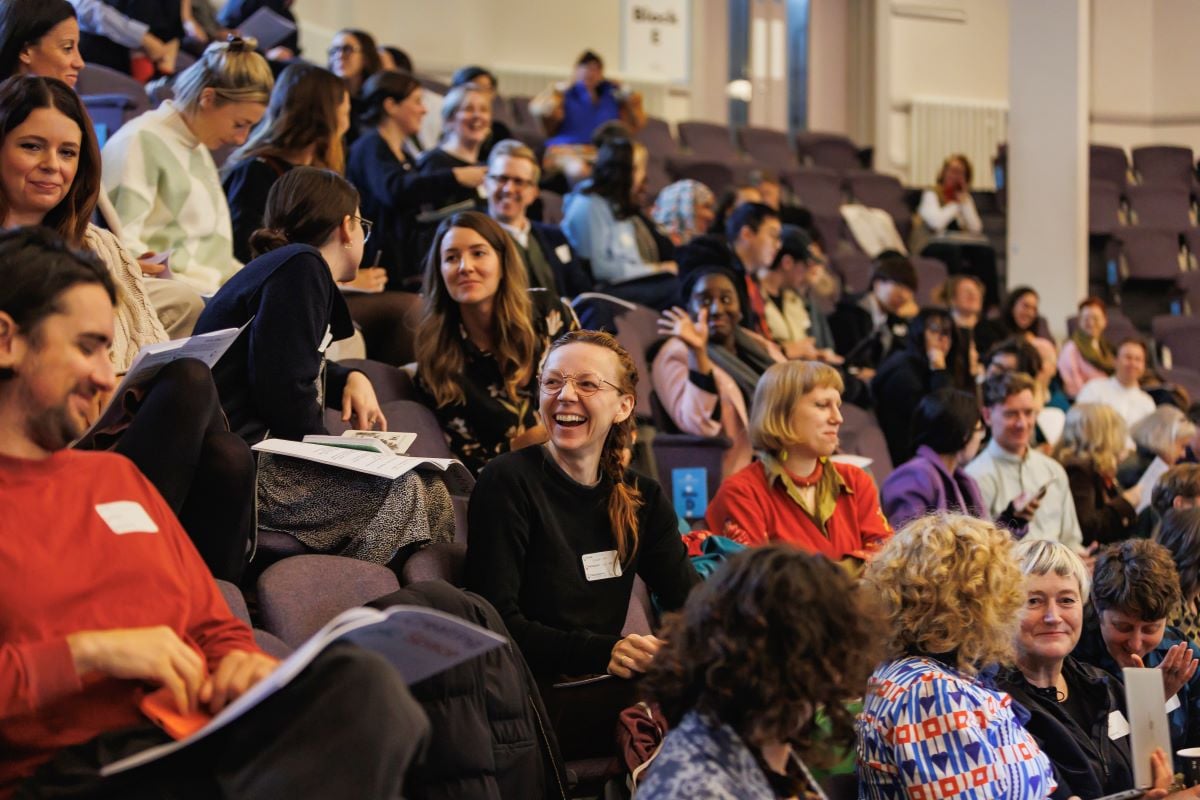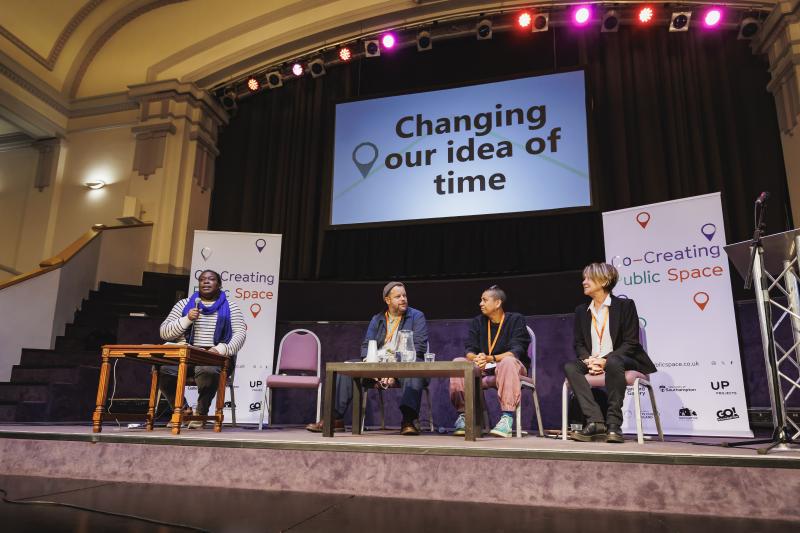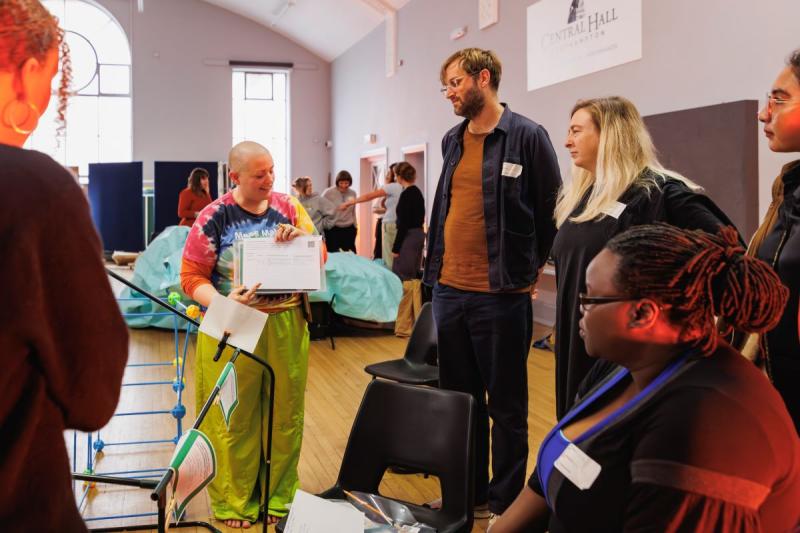
Delegates at Co-Creating Public Space: How Can We Thrive? Friday 27 October 2023
Photo: Nosa Malcolm
Co-creating public space: How can we thrive?
Public art is an opportunity for collective expression of identity. In his reflections on a recent conference, Woodrow Kernohan says co-creation offers the potential to realise more equitable futures together.
Last month, John Hansard Gallery and UP Projects co-hosted a conference exploring co-creating public space. Over 300 delegates from across the UK converged in Southampton for an intensive day of discussions and workshops about time, power and community assets.
A key takeaway from the conference and the wider programme* has been the understanding that working with communities requires different relationships with time. It is often down to artists to operate at the intersection of multiple and sometimes conflicting temporalities. Below are some of the highlights of the day.
Importantly, the conference began and ended with artist and community voices at the forefront. Community leader, Vikkie Cheng, from the Chinese Association of Southampton, opened with her experience of working with the artist Grace Lau on her Portraits In a Chinese Studio: “Our collaboration… was a vivid realisation of our shared mission to create spaces where diverse voices and cultures could come together and find common ground. Public art is an opportunity for communities to express their collective identity and culture. It's a means of democratising artistic expression, making it an integral part of the community.”
Changing our idea of time
The first panel – Changing our idea of time – was chaired by Sepake Angiama, who grounded the audience through a participative breathing exercise and etymology of the word 'social' (from the Latin socialis, involving partners, living in partnership, belonging to a fellowship, or relating to allies).
 Changing our idea of time panel at Co-Creating Public Space: How Can We Thrive? From left: Sepake Angiama, Owen Griffiths, Helen Cammock, Suzanne Lacy. Photo: Nosa Malcolm.
Changing our idea of time panel at Co-Creating Public Space: How Can We Thrive? From left: Sepake Angiama, Owen Griffiths, Helen Cammock, Suzanne Lacy. Photo: Nosa Malcolm.
Artist Helen Cammock shared an excerpt from her film I will keep my soul in which she created and held space to radically listen to communities in New Orleans. She followed the interviews with a poetic presentation about investing in participants and extending the time within her practice.
Owen Griffiths spoke about his hyperlocal projects and investing in long-term relationships with communities since returning to his hometown of Swansea. He reflected on his experience of slow time and his immersive approach to working with communities. His projects creating gardens and community events offer new opportunities for living more communally and collectively.
Artist and socially engaged pioneer, Suzanne Lacy, expanded the consideration of time. She spoke about her project Uncertain Futures in Manchester. Project and funding timelines are often at odds with the timescales of working with communities. This multi-year project has recreated opportunities for cross-community cohesion where the shared spaces of industry have disappeared.
She stressed the value of artists’ and communities’ time, but also said she had to subsidise projects through her teaching career. Both Helen and Owen emphasised the importance of paying artists and communities for their time.
We are all economists
The discussions about value and renumeration led directly to the second panel – We are all economists – chaired by Fatoş Üstek. Considering alternative economic models, Torange Khonsari, Co-Founder and Director of Public Works, highlighted the different yet intersecting spheres of private, public and the commons.
She cited Kate Raworth's theory of Doughnut Economics, relating the private sphere to the art market, the public sphere to government, local authority and institutions, and the commons to the collective and cooperative opportunities of socially-engaged practice. But the household is not considered in these wider economic models, just as the value of socially-engaged practice is not easy to measure and quantify.
Access to language and legislation can empower communities to use the structures and systems already in place, to take control of their own spaces. Considering communal value and mutual benefit, Raluca Voinea, Co-Director at tranzit.ro, explored innovative collective working practices and a return to agrarian models in Romania. She spoke about non-hierarchical and horizontal models, redistributing access for collective benefit and common good.
 Making access a priority workshop at Co-Creating Public Space: How Can We Thrive? Participants with Lady Kitt (centre). Photo: Nosa Malcolm.
Making access a priority workshop at Co-Creating Public Space: How Can We Thrive? Participants with Lady Kitt (centre). Photo: Nosa Malcolm.
In the afternoon, there were focused workshops: on accessibility, power structures, skateboarding in the city, publicness and conflicting agendas. A space for conversations, collaborations and new networks was forged.
Binki Taylor led the final panel to reflect on key insights from the day. Community members Beverley Dowdell from Black Heritage Southampton, and Vikkie Cheng spoke alongside artists Michael Elliott (visiting from Kingston, Jamaica) and Suzanne Lacy. Beverley shared her experience working as a nurse in the UK and how she learned to really listen, with the outcome of hearing more than was said. Patients often say they are alright when they are not.
Claire Whitaker, Chief Executive of Southampton Forward, brought the conference to a close with her vision for Southampton and an announcement of artist open calls and new public art steering group. Overall, it was a day of renewed focus on working with communities, public spaces, co-creation and the potential to realise new more equitable futures together.
Woodrow Kernohan is Director of John Hansard Gallery, University of Southampton.
![]() John Hansard Gallery | UP Projects | Co-Creating Public Space
John Hansard Gallery | UP Projects | Co-Creating Public Space
![]() @JHansardGallery | @upprojects | @CoCreateSoton |
@JHansardGallery | @upprojects | @CoCreateSoton |
*Co-Creating Public Space: How Can We Thrive? conference was curated by UP Projects and presented in partnership with John Hansard Gallery. It is part of Co-Creating Public Space, a 2-year programme of public art commissions led by John Hansard Gallery, with support from Arts Council England, Southampton City Council, GO! Southampton and University of Southampton.
*Grace Lau’s Portraits In a Chinese Studio continues at the Centre for British Photography, London until 17 December, Mary Evans’ and Michael Elliott’s Windrush Portraits continue until 4 February 2024 in Southampton city centre. Video recordings of the conference will be available on John Hansard Gallery, UP Projects, and Co-Creating Public Space websites.
Join the Discussion
You must be logged in to post a comment.